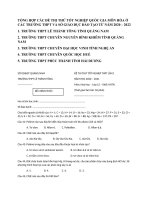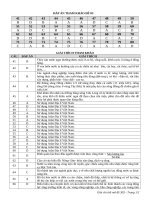Đề thi và đáp án văn học Anh Mỹ EN16
Bạn đang xem bản rút gọn của tài liệu. Xem và tải ngay bản đầy đủ của tài liệu tại đây (62.67 KB, 6 trang )
HANOI OPEN UNIVERSITY
MID -TERM TEST ON ENGLISH AND AMERICAN
LITERATURE
FOR STUDENTS OF ENGLISH (No 2)
Subject Code: EN16
Full name:
Date of birth:
Group:
I. Answer the following questions: (50 points)
1. What three languages were spoken in England in the 11th - 13th centuries, and
whom were they spoken by? Mention some reasons.
Three main languages spoken in England in the 11th - 13th centuries: Middle English,
Anglo-Norman (or French) and Latin.
Middle English: In 1066 William the Conqueror, the Duke of Normandy (part of
modern France), invaded and conquered England. The new conquerors (called the
Normans) brought with them a kind of French, which became the language of the
Royal Court, and the ruling and business classes. For a period there was a kind of
linguistic class division, where the lower classes spoke English and the upper classes
spoke French. In the 14th century English became dominant in Britain again, but with
many French words added. This language is called Middle English. It was the
language of the great poet Chaucer (c1340 – 1400), but it would still be difficult for
native English speakers to understand today.
Anglo-Norman (or French): Anglo-Norman, also known as Anglo-Norman French.
Anglo-Norman had emerged as a distinct dialect of French after the Norman Conquest
in 1066 established a French-speaking aristocracy in English. It was spoken in the law
courts, schools, and universities and, in due course, in at least some sections of the
gentry and the growing bourgeoisie. Private and commercial correspondence was
carried out in Anglo-Norman or Anglo-French though Anglo-Norman and AngloFrench were eventually eclipsed by modern English, they had been used widely
enough to influence English vocabulary permanently.
Latin:
− English was slow to take over as the language of government, law, and
bureaucracy, despite the fact that by a law passed in 1362 all legal pleadings had to be in
English. However, most other types of official documents continued to be written in
Latin, such as the manor court roll (MS 66/1) shown on the previous page of this unit. It
was not until the mid-sixteenth century that English began to appear in manorial records,
and even then it was often only used to record presentments spoken in that language at
the meeting of the manor court. It was a similar situation in the records of the Nottingham
Archdeaconry court. In depositions written in 1610, the words spoken by ordinary people
are written in English, as they said them, but the rest of the document explaining the case
is in Latin.
− Rentals and accounts from landed estates are rare in English before the beginning
of the sixteenth century. Most title deeds were also written in Latin until the sixteenth
century and even later.
− The Catholic church used Latin in its services, so all liturgical books were written
in this language until the Reformation in the sixteenth century. The theologian John
Wycliffe began to translate the Bible into English in the late fourteenth century, but the
Lollard movement with which he was associated was persecuted by the authorities, so
late medieval Bibles in English are rare.
2. What is a romance, a fabliaux, a bestiaria? In what language were they written?
Romance:
− In the strictest academic terms, a romance is a narrative genre in literature that
involves a mysterious, adventurous, or spiritual story line where the focus is on a quest
that involves bravery and strong values, not always a love interest. However, modern
definitions of romance also include stories that have a relationship issue as the main
focus.
− Types of Romance: Gothic (popular Gothic novels still read by many high school
students today are classics such as: Jane Eyre by Charlotte Bronte, Wuthering Heights by
Emily Bronte, Frankenstein by Mary Shelley); historical (The Last of the Mohicans by
James Fenimore Cooper, Rob Roy by Sir Walter Scott); contemporary/Modern (there can
be: comedy-romance, tragic-romance, satire-romance, serious romance)
− Romance is of course also associated with languages. That use was sealed a bit
earlier, back when the noun referred to Old French; the term Romance language now
refers to a number of languages that developed from Latin, including French, Italian, and
Spanish
Fabliaux:
− Fabliau (the plural form is fabliaux) is a comical fable told in verse. They were all
the rage in the 12th and 13th centuries. Fabliaux were typically told by jongleurs
(professional storytellers/public entertainers in France). The short stories were known for
their colorful and comical observations on life, sort of like a cynical and harsh Middle
Age version of Jerry Seinfeld. The stories took comedic shots at things like religion, the
sanctity of marriage, and the treatment of women.
− The fabliau style was simple and straightforward. The narratives were always
situated in present day and the characters were from the middle or lower classes. Fabliaux
made fun of everyday life. The plots were often centered on women with large sexual
appetites and men who were ignorant fools. There was typically some sort of scam or
practical joke in the narrative and trickery was usually successful.
− There are about 150 surviving fabliaux from various jongleurs from the over 200
or so years that the form was popular in medieval literature. However, one of the most
revered fabliaux writers in the history of storytelling was Geoffrey Chaucer.
Bestiaria
− Bestiary, a literary genre in the European Middle Ages consisting of a collection of
stories, each based on a description of certain qualities of an animal, plant, or even stone.
The stories presented Christian allegories for moral and religious instruction and
admonition.
− The numerous manuscripts of medieval bestiaries ultimately are derived from the
Greek Physiologus, a text compiled by an unknown author before the middle of the 2nd
century AD. It consists of stories based on the “facts” of natural science as accepted by
someone called Physiologus (Latin: “Naturalist”), about whom nothing further is known,
and from the compiler’s own religious ideas.
− The Physiologus consists of 48 sections, each dealing with one creature, plant, or
stone and each linked to a biblical text. The popularity of the Physiologus, which
circulated in the early Middle Ages only less widely than the Bible, is clear from the
existence of many early translations. It was translated into Latin (first in the 4th or 5th
century), Ethiopian, Syriac, Arabic, Coptic, and Armenian. Early translations from Greek
also were made into Georgian and into Slavic languages.
− Translations were made from Latin into Anglo-Saxon before 1000. In the 11th
century, an otherwise unknown Thetbaldus made a metrical Latin version of 13 sections
of the Physiologus. This was translated, with alterations, in the only surviving Middle
English Bestiary, dating from the 13th century. It, and other lost Middle English and
Anglo-Norman versions, influenced the development of the beast fable. Early translations
into Flemish and German influenced the satiric beast epic. Bestiaries were popular in
France and the Low Countries in the 13th century, and a 14th-century French Bestiaire
d’amour applied the allegory to love. An Italian translation of the Physiologus, known as
the Bestiario Toscano, was made in the 13th century.
II. Comments (50 points)
Write what you know about the life and works of Geoffrey Chaucer - The
founder of English realism
Geoffrey Chaucer is one of the greatest poets of England. He is known to be the
father of English poetry. This does not mean that there was no poetry, or poets in England
before him. But before Chaucer, there was no National language. There were merely a
number of regional languages. Chaucer used one of these languages, East Midland. By
the force of his genius, he raised it to the level of the national language of England. He
was, therefore, both the father of English poetry and the father of the English language.
He is the first national poet of England. Geoffrey Chaucer was the greatest writer of the
14th century. He was born around 1343 in London and died October 25, 1400, in London,
England, and was the first to be buried in Westminster Abbey’s Poet’s Corner. His father
and grandfather were both London wine merchants and before that, for several
generations, the family had been merchants in Ipswich. Although the Chaucers were not
of noble birth, they were extremely well-to-do.
The young Chaucer began his career by becoming a page to Elizabeth de Burgh,
fourth Countess of Ulster. In 1359, Chaucer traveled with Lionel of Antwerp, Elizabeth's
husband, as part of the English army in the Hundred Years' War. After his tour of duty,
Chaucer traveled in France, Spain, and Flanders, possibly as a messenger and perhaps as
a religious pilgrim. In 1367, Chaucer became a valet to the royal family, a position which
allowed him to travel with the king performing a variety of odd jobs. During this time,
Chaucer began to write poetry in French, experimenting with various forms. He was sent
to France a number of times on official court business and may have also traveled in Italy.
His relationship with John of Gaunt was by this time a sincere friendship. John's wife
Blanche, Duchess of Lancaster, died in September 1368 CE, and he fell into a period of
deep grief mourning her loss. Chaucer wrote his first major work, The Book of the
Duchess, in her honor and as a means of consoling his friend. Chaucer's first major work,
The Book of the Duchess, was an elegy for Blanche of Lancaster, but reflects some of the
signature techniques that Chaucer would deploy more deftly in his later works. It would
not be long, however, before Chaucer would produce one of his most acclaimed
masterpieces, Troilus and Criseyde. Like many other works of his early period
(sometimes called his French and Italian period) Troilus and Criseyde borrows its poetic
structure from contemporary French and Italian poets and its subject matter from classical
sources.
In 1374, Chaucer became Comptroller of the Customs for the port of London for
Richard II. While working as comptroller Chaucer moved to Kent and became a Member
of Parliament in 1386, later assuming the title of the clerk of the king's works, a sort of
foreman organizing most of the king's building projects. In this capacity, he oversaw
repairs upon Westminster Palace and St. George's Chapel. He may have begun The
Canterbury Tales while still in London, but more likely it was after he had left his
position at the customs house and moved to Kent. In the General Prologue of the poem, in
which he introduces his characters, Chaucer-as-narrator relates how the pilgrims, setting
out from the Tabard Inn at Southwark for Becket's shrine at Canterbury, will each tell two
stories on the way and two coming back; the one whose story is judged best wins a free
meal at the Tabard upon their return. The completed work would then have been
comprised of 120 tales, but Chaucer only wrote 24, which is why the piece is considered
unfinished. The Canterbury Tales is Chaucer's masterpiece, written at the height of his
poetic skill. The work is by turns satiric, tragic, ribald, and comic, varying from tale to
tale.
From 1386 CE on, Chaucer held a number of important and highly-paid positions
such as Justice of the Peace, a member of Parliament, Clerk of the King's Works, and
Deputy Forester of the Royal Forest. He was also a member of the Kent Peace
Commission and, as always, in service to the crown on various matters which are not
specified in the records. Chaucer was still at work on The Canterbury Tales when he
moved back to London in the 1390's CE. He rented a home near Westminster Abbey,
where he died in October of 1400 CE. He was buried in the abbey because he was a
member of the parish, but his grave would mark the first of the famous Poet's Corner of
Westminster Abbey where many great writers and poets have been buried or
memorialized since. The Canterbury Tales was first published by William Caxton in c.
1476 CE in London, and the work became a bestseller. Even in Chaucer's lifetime,
though, scribes had been copying and sharing his works so the claim that he only became
famous as a writer after his death is untenable. By c. 1500 CE, Chaucer's reading
audience had grown wider and he was hailed by critics for his poetic skill and vision. In
1556 CE, a marble monument to him was erected on his gravesite by the local poet
Nicholas Brigham citing Chaucer as the “bard who struck the noblest strains” in poetry
and his reputation has only grown in the centuries since.









